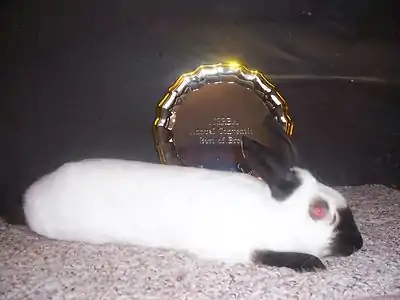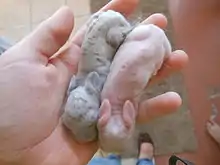Himalayan rabbit
The Himalayan rabbit is a rare medium-sized breed of rabbit easily mistaken for the Californian rabbit.[1] The body is white with colored points, recognized colors are black, blue, chocolate and lilac. They are one of the oldest and calmest breeds. Adult Himalayans weigh 2 1/2 to 4 1/2 pounds (1 to 2 kg) with an ideal weight of 3 1/2 pounds. They are the only cylindrical rabbit breed. The history of the breed is partially a mystery, as there are no definite records that clearly state where the breed may have originated. Some speculate that their origin may be in the Far East as opposed to the Himalayas, as their name suggests.

When Himalayans are raised in cold climates, they can exhibit black coloration of their coats, making them a phenocopy of the black rabbit.
Himalayans are also known as the Chinese, Egyptian, and Black-nose.[2] They are posed stretched out, and their body is to be 3.5 head lengths.[3] They have fine bone and a skinny body, and, unlike many other breeds, were never raised primarily for meat. This breed's main purpose is for show, but in its past, it was raised for its white pelt. Also, they are the only rabbit breed that commonly has an extra set of nipples. They are the ancestors of Californians, one of the most common meat rabbits.
History
Himalayan rabbits were one of the first breeds of rabbits, and their origin is unknown. It is unlikely that they came from the Himalayas though, as their name suggests. The original variety was the black Himalayan, and the blue Himalayan was created later. The chocolate and lilac varieties were made by different crosses depending on where they originated. American chocolate Himalayans were made by Ron Smelt of California by mixing chocolate English spots to Himalayans.[4] The lilacs were made by mixing the chocolate Himalayans the blues, but to create a color unique enough to get recognized as its own color (many early lilacs looked like light blues) lilac mini rexes were mixed in, but these lines were mostly destroyed after the color was accepted.
The Himalayan plays an important part in many other breed's histories, especially the Californians,[5] which looks like a large, meaty version of it. The Californian was made by crossing Himalayans with New Zealand's and a few other breeds (some Californian breeders say it is just Himalayan and New Zealand, while others say the Standard Chinchilla was mixed in too). The Californian was added to many other breeds (like Champagne d'Argents and some lines of Cinnamon) to improve body type, so Himalayan marked sports pop up sometimes.

Markings
The Himalayan rabbit is well known for its markings, which are similar to the Himalayan cats'. They have dark ears, front feet (socks), hind feet (boots), a dark tail, and a dark spot on nose (egg). The markings change with age and environment. The colder weather may darken markings, enlarge markings, and also add markings around the eyes and genitals (vent smut). These markings are not a disqualification because it is not on the usable portion of the pelt. If the markings spread into the usable portion of the pelt, such as into the belly or on the pin bones, it is a disqualification. Warmer weather may lighten markings, shrink markings, and cause white hairs in markings (known as "frosting"). In extreme warm weather, a Himalayan may even develop light or white toenails. Chocolate and lilac Himalayans usually have bigger markings than blacks and blues, and are more likely to develop disqualifying markings, known as "smut". Himalayans may develop smut after just ten minutes of contact to cold objects.
Baby Himalayans are especially sensitive to temperature. Most babies in the warmth of the nest will look the same as albino babies (because Himalayans can only produce eumelanin under a certain temperature and they cannot produce pheomelanin at all.) Himalayans will always have red eyes, and any Himalayan marked rabbits without red eyes are usually misidentified sable points. If a nest gets too cold or a baby falls out, they will get dark bands on their fur. This varies from looking to off-white to looking chinchilla-colored, and it causes confusion among many novice breeders. Because of their constantly changing colors, most Himalayan breeders do not look at markings as a factor when making breeding plans. A baby who was chilled in the nest box is often called "frosty," which is not to be confused with frosted pearl.

Genetics
Himalayans are known for having a double copy of the ch gene. They also have a black color, which is probably caused by a double copy of the a (self) gene. Then there are the variations with the B gene (chocolate) and the D gene (dilute). A Himalayan with bb will show up as chocolate, a Himalayan with dd will show up as blue and a Himalayan with both bb and dd will show up as lilac.
The Himalayan gene (ch) has been bred into many other breeds, they lack marking modifiers so they often show up with smaller, lighter markings.
Differences between other breeds
- Himalayans are the only breed posed stretched out (cylindrical)
- Himalayans are a common youth breed because of their good temperament
- European Himalayans and American Himalayans have different poses.
- Himalayans commonly have an extra set of teats.[6]
- Himalayans are one of 4 breeds that can be moved up to senior class regardless of their weight.
See also
References
- "BRC Breed Standard" (PDF). Archived from the original (PDF) on 2012-04-25. Retrieved 2011-12-04.
- American Himalayan Rabbit Association
- AHRA guidebook
- American Himalayan Rabbit Association Breed History
- ARBA Guidebook: Raising Better Rabbits and Cavies
- How many nipples do Himalayans have?